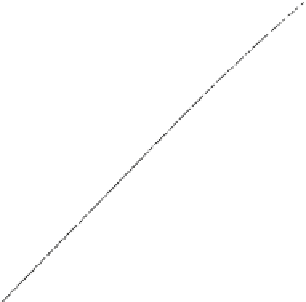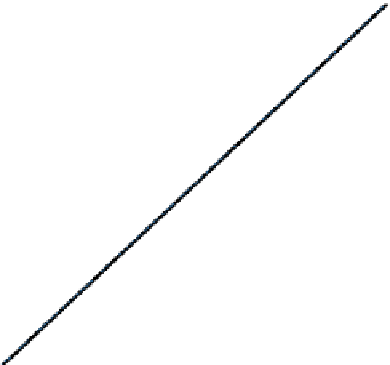Geoscience Reference
In-Depth Information
465
470
475
480
485
490
Cambrian
Ordovician
0
5
10
15
20
25
30
35
Position in scale
Fig. 9.36 Illustration of splining procedure with a small set of data points around the Cambrian-
Ordovician boundary.
Black dots
: Given data with stratigraphic and radiometric error bars (total
range and 2-sigma).
Black curve
: Spline of the given data, cross-validated smoothing factor
SF
1.075.
Blue dots
: Random replicate of the input data generated according the given points
and their error bars, SF
¼
2.125.
Blue curve
: Spline of the random replicate.
Green dots and curve
:
Another random replicate and its spline, SF
¼
0.85. The Cambrian-Ordovician boundary age from
the spline of the given data is 485.39 Ma. The ages computed from the random replicates are
485.17 and 487.06 Ma (Source: Gradstein et al.
2012
, Fig.14.1)
¼
s
(
y
i
), and by a smoothing factor (SF) representing the square root of the average
value of the sum of squares of scaled residuals
r
i
¼
{
y
i
f
(
x
i
)/
s
(
y
i
)}. If all
s
(
y
i
)
values are unbiased, SF
1, or SF is a value slightly less than 1 (
cf
. Agterberg
1994
,
p. 874). If SF significantly exceeds 1, this suggests that some or all of the
s
(
y
i
)
values used are too small (under-reported). Thus, if SF can be determined indepen-
dently, the spline-fitting method may provide an independent method of assessing
mutual consistency and average precision of published 2
¼
error bars. The smooth-
ing factor (SF) can be estimated in practice by cross-validation using the “leave-off-
one” method that produces an optimum smoothing factor (
cf
. Agterberg
2004
).
Figure
9.36
(from Agterberg et al.
2012
, Figure 14.1) illustrates splining on a
small data set consisting of six Cambrian and Ordovician data points in the vicinity
of the Cambrian-Ordovician boundary. In this application, the relative geological
˃





















































































































































































































Search WWH ::

Custom Search